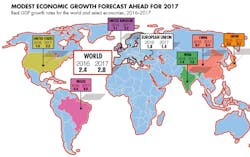From the big global players to niche specialists, electronics distributors are generally optimistic about 2017. Their reading of the usual metrics—GDP growth, interest rates, book-to-bill ratios, DTAM—all point to low single-digit revenue growth in the New Year. This is good news, considering the languid market conditions that have dominated the market since the Great Recession of 2008, the subsequent collapse of oil and commodity prices in 2014, and the reverberations in 2015 and 2016.
“I’m pretty bullish on 2017,” says Michael Knight, TTI’s senior vice president, Americas. “We have nice momentum and leading indicators are looking good. It won’t be a barn burner, but it’ll be a good year for the industry.”
Whether this broadly held optimism is justified and will herald sustainable growth for the next 12 months depends on two factors. The first is the growing uncertainty about global economic performance due in large part to rising populism around the world. The second, and related factor, is the impact this uncertainty will have on the pace of new technology adoption.
Managing Economic Uncertainty
Deriving the heightened economic uncertainty is the political challenge to government policies that for two decades have promoted globalization. In June, the UK surprised itself and the world by voting to leave the European Union. Five months later, the U.S. shocked the world again by electing Donald J. Trump as the 45th president of the United States.
Both have impacted global stock markets and exchange rates and have called into question expectations about government policies, trade agreements, inflation, and global economic growth. Indeed, economists are busy revising their economic forecasts for 2017 and beyond.
How much of an economic impact a Trump administration will have on U.S. and global economic performance is a moving target. It depends on whether the new administration pursues protectionist policies espoused during the campaign or more pragmatic, pro-growth policies. If the latter—which, as of the beginning of December, is what many economists expect—then U.S. economic growth, inflation and interest rates are all expected to rise, which economists believe will benefit most economies. One of Trump’s most important pro-growth policies is a commitment to increase government spending on infrastructure programs.
Independently, global commodity prices of ferrous and non-ferrous metals have been on the rise, which are expected to contribute to inflationary pressure. The price hikes are caused by the cyclical nature of commodity prices but more recently have been in response to the expectation of higher infrastructure spending in the U.S., some economists suggest.
With inflationary pressures mounting, the U.S. Federal Reserve Bank is likely to hike interest rates in mid-December. Pundits expect the Fed to accelerate the pace of rate hikes through 2017 to prevent the US economy from overheating.
According to IHS Economics’ November Global Executive Summary newsletter, world GDP growth is projected to be 2.8% in 2017, a healthy increase from 2.4% in 2016. IHS Economics forecasts US growth to be between 2.0% and 2.5% in 2017, up from 1.5% in 2016. (See Fig. 1.)
World GDP growth is projected to be 2.8% in 2017, a healthy increase from 2.4% in 2016. IHS Economics forecasts US growth to be between 2.0% and 2.5% in 2017, up from 1.5% in 2016.
“We see more imports into the U.S., a stronger dollar, and stronger U.S. growth due in large part to the proposed infrastructure programs of the Trump administration,” says Chris Christopher, director, U.S. and Global Consumer Economics, IHS Economics, IHS Markit. “This points to an increase in technology investment.”
Electronic Components Industry Association (ECIA) members largely agree with the IHS US outlook. Fourth quarter 2016 growth projections based on a recent survey of ECIA members found that in all component categories—connectors, electromechanical, resistors, semiconductors, etc.—and all industry sectors—automotive, consumer, industrial, medical, etc.—a significant percent of members expected growth of 1% or more.
“We are polling our members now, but I suspect the trend will continue through 2017,” says John Denslinger, ECIA president and chief executive. “The semiconductor companies have done an excellent job of integrating acquisitions with little to no impact on lead times.”
Of course, there is the potential for more economic shocks to come. In 2017, the Netherlands, France and Germany all have elections, which could lead to protectionist policies with potential negative implications for economic growth, exchange rates and business confidence. “If there’s political turmoil in Europe, the Euro could take hit after hit after hit,” says Christopher.
IHS Economics is projecting persistent lackluster GDP growth for the European Union, with GDP growth dropping to 1.4% in 2017 from 1.8% in 2016.
Turning to Asia, China’s economic growth is expected to slow from 6.7% in 2016 to 6.4% in 2017, according to IHS Economics. Growth is expected to remain in that range for the next few years as the country continues its economic shift from export-led growth to domestic market growth. As part of a managed exchange-rate reduction, China’s currency, the renminbi, has been falling steadily in value against the U.S. dollar and is expected to continue to fall in 2017.
If the Trump administration follows through with the stated plans to abandon the 12-nation Trans-Pacific Partnership (TPP) trade deal, China is expected to fill the void. “China believes we should set a new and very practical working plan, to positively respond to the expectations of industry, and sustain momentum and establish a free trade area in Asia-Pacific at an early date,” said Li Baodong, China’s vice-foreign minister in November.
Japan, which is a TPP participant, is perhaps the economy that has been hurt the most by China’s pivot and stands to suffer the most from U.S. protectionism policies. Its economy remains weak and is expected to post GDP growth in 2017 of just 0.7%, a slight improvement over 0.6% growth in 2016, according to IHS Economics. On the bright side, Japan stands to gain from the prospect of higher economic growth in the U.S.
The uncertainty around trade pacts raises concerns for the global electronics value chain, including the physical global footprint of distributor operations. “Because of the threat of increased protectionism, it would be advantageous for electronics distributors and manufacturers to have an economic presence in every trading bloc, thereby avoiding potential trading negatives such as tariffs, duties, and currency manipulation,” cautions Denslinger.
Managing IoT Uncertainty
It’s impossible to have a conversation about distributor business growth without mention of the Internet of Things (IoT), Industry 4.0, cloud and SaaS computing, artificial intelligence (AI), machine learning, and a variety of other disruptive technology trends. Their long-term collective market and social impact is profound and the revenue potential in component sales for the electronics value chain is significant.
In August, Machina Research forecast that the global IoT market would grow from 6 billion connected devices today to 27 billion by 2025, generating $3 trillion in revenue. That includes revenue from device sales, connectivity, service and application revenue, as well as application development, systems integration, and managing and monetizing data.
In June, International Data Corporation forecast U.S. organizations would invest over $230 billion in IoT in 2016, and the investment level would grow at a compound rate of 16% through 2019. The top applications are in manufacturing operations, freight management, and smart buildings, according to IDC.
The driver for most of this spending is cost reduction and improved efficiency, including energy efficiency, according to Douglas Handler, chief economist, i-Futurist. “We haven’t seen the productivity gains yet because it takes a long time and a lot of investment,” he says.
Electronics distributors know the projections and have been anticipating a bump in revenue from IoT for a few years. However, to date the impact has not been evident. “Sensors are a fast-growing business for us but they are mainly in traditional markets,” says TTI’s Knight.
Still, many distributors believe 2017 will be the year of IoT. “I think the industrial market is finally starting to get a lift from IoT,” says Gerry Fay, president, Global Electronic Marketing, Avnet. “We are starting to see machine-to-machine applications for IoT, such as predictive maintenance and dispatching.”
While it’s too early to quantify the lift from IoT-related investments, there are economic factors that could either accelerate adoption rates. At the same time, there are other factors that could slow the pace of IoT adoption.
On the positive side is the promise of federal government support for infrastructure investments. “If the government pursues an honest nationwide infrastructure investment, smart cities and IoT will be big winners that will drive strong semiconductor and sensor demand for next several years,” says ECIA’s Denslinger.
Prior to the election, the market potential for smart-city IoT spending was estimated to hit $1.6 trillion by 2020, according to Frost & Sullivan. From traffic management to information kiosks, security, water waste management and energy efficiencies, investments in smart-city projects account for the lion’s share of IoT investment to date.
On the negative side, other policy implications could decelerate IoT adoption. The Trump administration’s position on climate change, for example, may de-emphasize government projects aimed at reducing greenhouse gas emissions. This may include smart city and other IoT investments earmarked for boosting energy efficiency.
Similarly, the growth of autonomous vehicles may be slowed. Tesla Motors, for example, relies on a $7,500 federal tax credit to promote sales of its electric Model S, a luxury car with advanced driver assistance systems (ADAS). Tesla’s Model 3, due to be released in late 2017, has a lower retail price point than the Model S and is aimed at the mass market. The Model 3 has the potential to be a catalyst for autonomous-vehicle adoption, which would likely accelerate IoT investments, specifically ADAS and vehicle-to-vehicle and vehicle-to-infrastructure investments.
However, there is speculation that the Trump administration may eliminate the federal tax credit for energy efficient electric vehicles. This would have a short-term impact for Tesla and other car makers developing electric vehicle, which could slow the adoption of electric autonomous vehicle sales and impact the growth rate of IoT in the automotive sector.
While it is too soon to tell, the uncertainty these options present increases the perception of risk, which could delay investment.
Expectations about elections in Europe in 2017, particularly in France and Germany, may contribute to the uncertainty—and business risk—as both France’s National Front party and Germany’s Alternative for Germany (AfG) party are climate-change skeptics. Both the National Front and AfG are expected to make gains in 2017.










